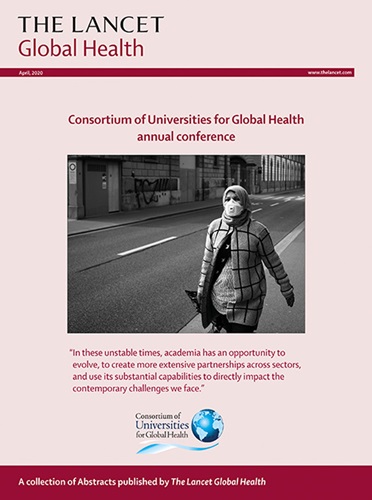When are postpartum haemorrhages diagnosed? A nested observational study within the E-MOTIVE cluster-randomised trial.
IF 19.9
1区 医学
Q1 PUBLIC, ENVIRONMENTAL & OCCUPATIONAL HEALTH
引用次数: 0
Abstract
BACKGROUND The definition of primary postpartum haemorrhage as blood loss of 500 mL or more within 24 h after vaginal birth underemphasises the early postpartum hours due to limited data on the timing of postpartum haemorrhage diagnosis. Understanding postpartum haemorrhage diagnosis timing and diagnostic methods is important for guiding diagnostic and therapeutic strategies. The E-MOTIVE trial evaluated early postpartum haemorrhage diagnosis and a bundled treatment approach, which resulted in a 60% relative reduction in adverse outcomes from bleeding compared with usual care. We aimed to compare timing from vaginal birth to postpartum haemorrhage diagnosis and the diagnostic methods used among four African countries implementing the intervention from the E-MOTIVE trial. METHODS Nested within the E-MOTIVE trial (NCT04341662), we conducted direct observations of health-care workers providing clinical care to postpartum women at 39 hospitals implementing the E-MOTIVE intervention across Nigeria, Kenya, Tanzania, and South Africa. One to two weeks of continuous observations were conducted from vaginal birth up to 2 h, between June 27, and Dec 18, 2022. Health-care workers were trained to use clinical judgement (ie, heavy vaginal blood loss, large blood clots expelled, or constant trickle) and various objective blood loss thresholds to diagnose postpartum haemorrhage. The objective blood loss thresholds used in Nigeria, Kenya, and Tanzania were 300 mL or more with at least one abnormal clinical sign (ie, pulse, blood pressure, uterine tone, and vaginal blood flow) or 500 mL or more. The objective blood loss threshold in South Africa was 500 mL or more. We descriptively analysed and compared timing from vaginal birth to postpartum haemorrhage diagnosis and diagnostic methods used between countries. FINDINGS Of 2578 women, 295 postpartum haemorrhages were diagnosed. The median time from vaginal birth to postpartum haemorrhage diagnosis was 15 min in Nigeria and Tanzania, 17 min in Kenya, and 30 min in South Africa. Diagnosis within 30 min ranged from 58% in South Africa to 86% in Tanzania. By 60 min, 96% to 100% of postpartum haemorrhages were diagnosed across all countries. All postpartum haemorrhages that required an intervention were diagnosed within 90 min. Nigeria, Kenya, and Tanzania commonly used blood loss of 300 mL or more combined with at least one abnormal clinical sign (47%, 65%, and 68%, respectively) while South Africa relied on a definition of 500 mL or more (81%) as the dominant diagnostic strategy. INTERPRETATION In countries where an objective blood loss threshold of 300 mL or more with at least one abnormal clinical sign was used, women received earlier interventions for postpartum bleeding, with a median time to diagnosis of 15-17 min. This was notably faster than in the country that predominantly used a 500 mL or more threshold, where the median time to diagnosis was 30 min. Regardless of whether the threshold was 300 mL or more with abnormal clinical signs or 500 mL or more alone, all postpartum haemorrhages were diagnosed within 90 min of vaginal birth. FUNDING Bill & Melinda Gates Foundation and Ammalife.产后出血什么时候诊断?E-MOTIVE集群随机试验中的嵌套观察性研究。
背景:由于有关产后出血诊断时间的数据有限,将阴道分娩后24小时内失血500 mL或更多定义为原发性产后出血,低估了产后早期的重要性。了解产后出血的诊断时机和诊断方法对指导诊断和治疗策略具有重要意义。E-MOTIVE试验评估了产后早期出血诊断和捆绑治疗方法,与常规护理相比,出血的不良后果相对减少了60%。我们的目的是比较从阴道分娩到产后出血诊断的时间以及在四个实施E-MOTIVE试验干预措施的非洲国家中使用的诊断方法。方法在E-MOTIVE试验(NCT04341662)中,我们对尼日利亚、肯尼亚、坦桑尼亚和南非39家实施E-MOTIVE干预措施的医院中为产后妇女提供临床护理的医护人员进行了直接观察。在2022年6月27日至12月18日期间,从阴道分娩到2小时,进行了一至两周的连续观察。对保健工作者进行了培训,使其能够使用临床判断(即阴道大量失血、大量血块排出或不断滴流)和各种客观失血阈值来诊断产后出血。尼日利亚、肯尼亚和坦桑尼亚采用的客观失血量阈值为300ml及以上,且至少有一种临床体征(即脉搏、血压、子宫张力和阴道血流)异常或500ml及以上。南非的客观失血量阈值为500ml或更高。我们描述性地分析和比较了从阴道分娩到产后出血诊断的时间和各国使用的诊断方法。结果2578名妇女中,295名被诊断为产后出血。从阴道分娩到产后出血诊断的中位时间在尼日利亚和坦桑尼亚为15分钟,在肯尼亚为17分钟,在南非为30分钟。30分钟内的诊断率从南非的58%到坦桑尼亚的86%不等。到60分钟时,所有国家96%至100%的产后出血被诊断出来。所有需要干预的产后出血均在90分钟内诊断出来。尼日利亚、肯尼亚和坦桑尼亚通常使用失血300毫升或以上并伴有至少一种异常临床体征(分别为47%、65%和68%),而南非则依赖500毫升或以上的定义(81%)作为主要诊断策略。在客观失血量阈值为300毫升或以上且至少有一种异常临床体征的国家,妇女接受较早的产后出血干预,诊断的中位时间为15-17分钟。这明显快于主要使用500毫升或更多阈值的国家,其中诊断的中位时间为30分钟。无论阈值是300ml及以上伴有异常临床体征,还是单独500ml及以上,所有产后出血诊断均在阴道分娩后90min内。资助比尔及梅琳达·盖茨基金会和Ammalife。
本文章由计算机程序翻译,如有差异,请以英文原文为准。
求助全文
约1分钟内获得全文
求助全文
来源期刊

Lancet Global Health
PUBLIC, ENVIRONMENTAL & OCCUPATIONAL HEALTH-
CiteScore
44.10
自引率
1.20%
发文量
763
审稿时长
10 weeks
期刊介绍:
The Lancet Global Health is an online publication that releases monthly open access (subscription-free) issues.Each issue includes original research, commentary, and correspondence.In addition to this, the publication also provides regular blog posts.
The main focus of The Lancet Global Health is on disadvantaged populations, which can include both entire economic regions and marginalized groups within prosperous nations.The publication prefers to cover topics related to reproductive, maternal, neonatal, child, and adolescent health; infectious diseases (including neglected tropical diseases); non-communicable diseases; mental health; the global health workforce; health systems; surgery; and health policy.
 求助内容:
求助内容: 应助结果提醒方式:
应助结果提醒方式:


